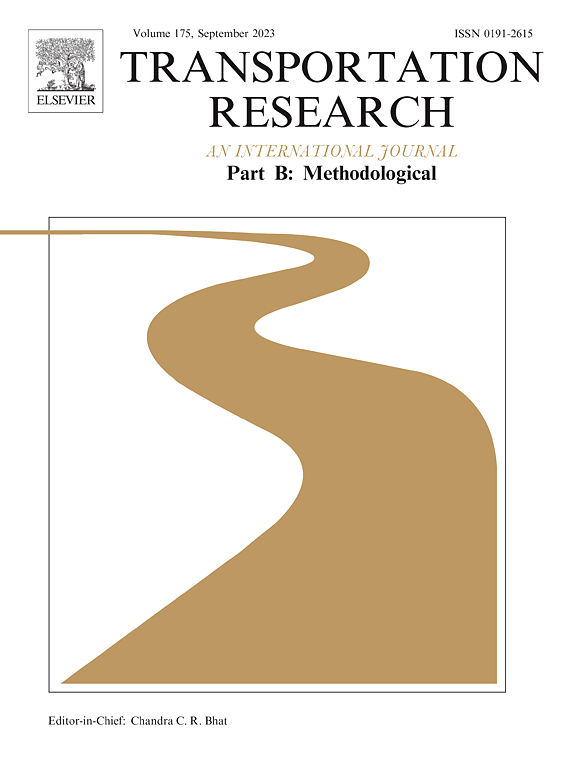Dynamics in credit-based mobility systems: Convergence to periodic mode usage equilibrium
IF 6.3
1区 工程技术
Q1 ECONOMICS
引用次数: 0
Abstract
This study examines the flow, behavior, and credit dynamics under a credit charge-cum-reward (CCR) scheme that operates periodically. In this scheme, travelers incur an end-of-period credit cost, determined by their periodic mode usage patterns, in addition to regular mode-specific time and monetary costs. As such, travelers are incentivized to make decisions minimizing individual periodic travel costs rather than focusing solely on daily cost minimization. To formulate a CCR-scheme-based dynamic system, we analyze travelers’ intra-period and inter-period learning behaviors and propose two adaptation rules—myopic and forward-looking—for travelers making day-to-day choices. We provide optimal strategies for each traveler under these two rules and derive stability conditions for the dynamic system. Our findings demonstrate that, under mild conditions, both rules, along with travelers’ learning behaviors, lead the dynamic system to converge to a periodic mode usage equilibrium (PUE), where each traveler minimizes their periodic travel costs. Numerical examples illustrate the variations in system performance and traveler behavior across two adaptation rules. This study not only explores the evolution of a CCR-scheme-based dynamic mobility system toward the PUE but also highlights the distinct adaptation behaviors under periodic mobility management policies.
基于信用的移动系统动力学:收敛到周期模式使用平衡
本研究考察了定期运行的信用收费加奖励(CCR)方案下的流程、行为和信用动态。在这个方案中,除了特定于常规模式的时间和金钱成本外,旅行者还要承担由他们的周期模式使用模式决定的期末信用成本。因此,旅行者被激励去做最小化个人定期旅行成本的决定,而不是仅仅关注每天的成本最小化。为了构建基于ccr方案的动态系统,我们分析了出境者的期内和期间学习行为,并针对出境者的日常选择提出了短视和前瞻两种适应规则。在这两种规则下给出了每个出行者的最优策略,并导出了动态系统的稳定性条件。我们的研究结果表明,在温和的条件下,这两种规则以及出行者的学习行为导致动态系统收敛到周期模式使用平衡(PUE),其中每个出行者的周期旅行成本最小。数值例子说明了两种适应规则下系统性能和出行者行为的变化。本研究不仅探讨了基于ccr方案的动态迁移系统向PUE的演变,而且强调了周期性迁移管理政策下不同的适应行为。
本文章由计算机程序翻译,如有差异,请以英文原文为准。
求助全文
约1分钟内获得全文
求助全文
来源期刊
CiteScore
12.40
自引率
8.80%
发文量
143
审稿时长
14.1 weeks
期刊介绍:
Transportation Research: Part B publishes papers on all methodological aspects of the subject, particularly those that require mathematical analysis. The general theme of the journal is the development and solution of problems that are adequately motivated to deal with important aspects of the design and/or analysis of transportation systems. Areas covered include: traffic flow; design and analysis of transportation networks; control and scheduling; optimization; queuing theory; logistics; supply chains; development and application of statistical, econometric and mathematical models to address transportation problems; cost models; pricing and/or investment; traveler or shipper behavior; cost-benefit methodologies.

 求助内容:
求助内容: 应助结果提醒方式:
应助结果提醒方式:


